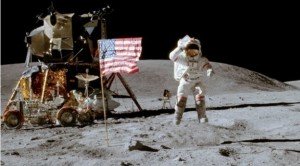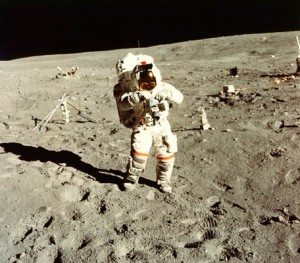The Moon Landing Conspiracies
 July 20th 1969, the day ‘the eagle landed’ and Neil A. Armstrong took his famous “one small step for a man and one giant leap for mankind”, was humanity’s proudest moment—or was it? So incomprehensible was the news that we had landed a manned craft on the moon, that it temporarily brought together a world steeped in political conflict. The moon landing was born out of the space race—in itself yet another manifestation of the cold war—and it was certainly a major coup for the USA, but the sheer accomplishment of it had a profound effect on people the world over. For a brief moment, the world came to a standstill as images were beamed from the moon in a testimonial to what humans are capable of.
July 20th 1969, the day ‘the eagle landed’ and Neil A. Armstrong took his famous “one small step for a man and one giant leap for mankind”, was humanity’s proudest moment—or was it? So incomprehensible was the news that we had landed a manned craft on the moon, that it temporarily brought together a world steeped in political conflict. The moon landing was born out of the space race—in itself yet another manifestation of the cold war—and it was certainly a major coup for the USA, but the sheer accomplishment of it had a profound effect on people the world over. For a brief moment, the world came to a standstill as images were beamed from the moon in a testimonial to what humans are capable of.
Yet there is another side to this momentous achievement. Almost from the very moment Neil Armstrong and Buzz Aldrin set foot upon the moon at Tranquillity Base, rumours and doubts started spreading that would gradually grow into one of the most controversial conspiracy theories ever. Debates on whether it was all just a big publicity scam aimed at getting one over on the Russians and pulling the wool over our eyes may be far fetched to some, but they have nonetheless cast a shadow over NASA and the entire space programme; after all, if the moon landing could have been simulated in a TV studio, then how certain can we be about anything we are told? Paranoia? Most likely, but a good conspiracy theory is credible enough and raises just enough questions to start you doubting…
So why are there doubts in the first place? A great many supposedly dubious details have been picked up by people ranging from healthy sceptics to paranoid conspiracy fanatics, but perhaps the underlying reason why so many people question the authenticity of the moon landings is the simple fact that it happened so far away and there were no witnesses—in the physical sense that is. Let’s face it, we pretty much have to take NASA’s word for it. Probably this very fact accounts for the proliferation of arguments and counter-arguments. According to official records, five missions took a total of ten astronauts to the moon between 1969 and 1972. These ‘moonwalkers’ brought back photos, film footage and large quantities of rock and sand samples collected from the moon’s surface, but it is exactly this evidence that has fuelled the scepticism of the disbelievers.
Although the rocks were definitely found not to be from earth, critics claim this does not necessarily mean they were picked up on the moon, as they could well have been meteoric fragments found on earth. The same critics claim that, even though the Moon Landing was ‘witnessed’ by hundreds of millions of people the world over, the clarity of reception of late 1960s television was not conducive to close scrutiny. In fact, they convincingly point out that many of the science fiction movies that have been made since look more ‘realistic’. More contentious than either the rock samples or the film footage, however, have been the photographs taken on the moon. They provide the basis for much of the Moon Landing conspiracy theory, sparking a vociferous tide of claim and counter-claim. Study the photos of the astronauts frolicking on La Luna and in many cases you will come across shadows which are not parallel to one another. According to the conspiracy theorists, there is no reason why the shadows of two people standing close to each other should not be in line, as is the case on earth. They argue that as the moon has only one source of light—the sun—and the lack of atmosphere makes both images and shadows very clear, the irregular angles of the astronauts’ shadows are clear evidence that there were additional—manmade—light sources.
Just as soon as the inconsistencies in the angles, lengths and shapes of the shadows are explained by deviations inherent in the laws of physics, critics throw another load of questions at NASA. Why is the light in the photos soft and diffused, and not sharp, as one would expect in a vacuum? Why are there no stars in the black skies above the astronauts’ heads? Why are the reflections off their visors so strange? Why are the suits of men standing with their backs to the sun so bright? In a place like the moon, everything that faces the sun is covered in blinding, unfiltered sunlight, but turn around and you become a dark outline, covered in your own shade. At least, this is what the detractors say. According to NASA scientists, such claims only serve to expose their lack of scientific knowledge and all the so-called doubts can be explained with scientifically sound arguments. The surprisingly bright astronaut suits are caused by the highly reflective qualities of the moon’s surface, which contains a high degree of crystallised, glass-like, minerals; The plain black skies are the result of fast shutter speeds, necessary to keep the photos from being completely washed out with bright sunlight; The soft light in the photos is caused by the advanced type of film that was specially developed for use in the temperature extremes of the moon.
 Okay, but what about the fact that the light source reflected on the astronauts’ visors is too large to be the distant sun? Again, scientists offer an apparently straightforward explanation: the strongly convex shape of the visors simply distorts and magnifies the image. Yet not all arguments are that easily rebuffed. Claims that the Lunar Module (LM) was too small to carry the Lunar Rover buggy are downright silly—it folds up into a compact package—but why is it that no blueprints or technical specifications of the spacecraft can be found and Grumman Aviation Corporation, its maker, claims that they have been destroyed? It seems to underpin doubts voiced by experts at the time, who believed that neither the USA nor the USSR, which was ahead in the space race back then, had the technology required to land people on the moon. In questioning how the USA could have caught up so suddenly they also draw attention to the apparent lack of interest in manned lunar missions on the part of the Russians, both before and after 1969.
Okay, but what about the fact that the light source reflected on the astronauts’ visors is too large to be the distant sun? Again, scientists offer an apparently straightforward explanation: the strongly convex shape of the visors simply distorts and magnifies the image. Yet not all arguments are that easily rebuffed. Claims that the Lunar Module (LM) was too small to carry the Lunar Rover buggy are downright silly—it folds up into a compact package—but why is it that no blueprints or technical specifications of the spacecraft can be found and Grumman Aviation Corporation, its maker, claims that they have been destroyed? It seems to underpin doubts voiced by experts at the time, who believed that neither the USA nor the USSR, which was ahead in the space race back then, had the technology required to land people on the moon. In questioning how the USA could have caught up so suddenly they also draw attention to the apparent lack of interest in manned lunar missions on the part of the Russians, both before and after 1969.
Although questions regarding the fairly serious radiation that the astronauts should have been exposed to at and en route to the moon were never satisfactorily answered, it was the rumour that recent lunar probes could not detect either the American flag or any of the other equipment left behind by the moonwalkers, that really reanimated the whole controversy. Listening to such claims has the unnerving effect of making you doubt not only whether we did ever set foot on the moon, but it opens up a whole spectrum of doubts and suspicions. Surely no conspiracy of this scale could ever be possible, or could it?
By Michel Cruz










